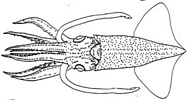Abralia multihamata
Kotaro TsuchiyaIntroduction
A. multihamata is a species endemic to the shelf waters along the south of Sagami Bay, Japan to Formosa. It is characterized by the scattered arrangement of ventral mantle photophores, six club hooks, and more than five eye photophores of two types. The taxonomic status with A. spaercki is problematic.Characteristics
- Tentacle club
- About six hooks on ventral side.
- Two rows of large suckers on dorsal side.
 image info
image info
- Hectocotylus
- Hectocotylus
- Right ventral arm of male hectocotylized.
- Hectocotylus with two different-sized offset flaps.
 image info
image info
- Eye Photophores
- Five major organs: two large opaque, terminal organs and three intermediate silvery organs; small silvery additional organs present.
 image info
image info
- Integument Photophores
- Ventral mantle with scattered arrangement of integumental organs.
- Ventral head with indistinct striped arrangement of integumental organs.
Life history
Age and reproduction
Spent specimens are collected in large number from the East China Sea in October by bottom trawl.Distribution
Vertical distribution
A. multihamata is possibly bottom associated or mesopelagic boundary species. Specimens were collected by bottom trawl from the East China Sea.
Geographical distribution
This species was first described from Formosan waters. It is distributed in shelf waters of the East China Sea, northward to Sagami Bay and the eastern sector of the Japan Sea.Title Illustrations
Abralia multihamata, Sagami Bay, Japan, from Tsuchiya, 2000, size, female.
Other illustrations
- Tentacle club, Sagami Bay, Japan, from Tsuchiya, 2000, size, sex.
- Hectocotylus (modified part), Sagami Bay, Japan, from Tsuchiya, 2000, size, male.
About This Page
Tokyo University of Fisheries, Konan, Minato, Tokyo
Page copyright © 2000
Citing this page:
Tsuchiya, Kotaro. 2000. Abralia multihamata . Version 01 January 2000 (under construction). http://tolweb.org/Abralia_multihamata/19658/2000.01.01 in The Tree of Life Web Project, http://tolweb.org/








